What is Inland Empire about?
While the non-linear structure of Inland Empire may seem intimidating when compared with traditional movie storylines, the narrative thrust of the film was summed up by David Lynch with four simple words: “A woman in trouble.” The attempt to connect every narrative thread in Inland Empire would prove fruitless as Lynch didn’t even assemble a master script that tied all these events together—he crafted the film over the course of several months as ideas came to him. “There are very specific ideas,” Lynch said in an interview with Richard A Barney, “…and a job to do to translate those ideas, to be true to those ideas.” Inland Empire is an amalgamation of characters that represent these ideas—these themes, these fears and anxieties, these desires, this existential dread. Sure, the spatiotemporal space of the film is random and scattershot and non-linear. But the ideas are consistent across all the situations that plague the characters played by Dern. And like any classic story, there is indeed emotional catharsis at the end for her.
If there is a coherent story in Inland Empire, it lies with Nikki, who is hired for a film and then loses herself in the character. Nikki is an aging actress looking for a comeback, and her latest film, On High in Blue Tomorrows, could be her ticket. But before she gets the job, Visitor #1 shows up at Nikki’s home and says some strange things. Visitor #1 envisions a murder will take place in the film, which causes Nikki to have a vision where she secures the lead role. From that moment forward, the rest of the film is a symbolic display of Nikki’s chaotic mindset upon accepting this role. Her goal is to finish a movie that is a remake of a movie that was never finished called 47. By completing this movie, she can free the “Lost Girl,” who is trapped in the movie that was never completed.
This serves as commentary on acting in general, as the art requires an actress to tap into the deepest recesses of her mind to inhabit a character. This would unavoidably force the actress to dig up some buried, unwanted memories that are essential to realizing the character. The entire movie is then Nikki’s journey to come out the other side of this character her original self—or perhaps, thanks to this arduous cinematic journey, a much more realized and assured version of herself. When the movie is complete, she and the Lost Girl can embrace and laugh and sing and dance. Emotional catharsis.
Cast
- Laura Dern – Nikki Grace / Sue Blue
- Jeremy Irons – Kingsley Stewart
- Justin Theroux – Devon Berk / Billy Side
- Harry Dean Stanton – Freddie Howard
- Julia Ormond – Doris Side
- Diane Ladd – Marilyn Levens
- Peter J. Lucas – Piotrek Krol / Smithy
- Grace Zabriskie – Visitor #1
- Mary Steenburgen – Visitor #2
- Karolina Gruszka – Lost Girl
- Krzysztof Majchrzak – Phantom
- Ian Abercrombie – Henry, The Butler
- Nae – Street Woman
- Terry Crews – Street Man
- David Lynch – Writer and director
The ending of Inland Empire explained
A recap of Inland Empire‘s ending
For this explanation, we’ll cover the final 30-ish minutes of Inland Empire. This gives us quite a bit of material to chew on as we explore the ending and its meaning.
After being stabbed with a screwdriver, Nikki stumbles across the street and collapses next to a few homeless people. One woman tells a strange story about her friend Niko, who has a pet monkey that shits everywhere. Then the other woman turns her attention to Nikki. “I’ll show you the light now,” she says as she lights a lighter in front of Nikki’s face. “It burns bright, for heaven. No more blue tomorrows. You goin’ high now love.” Nikki then dies—only for it to be revealed that she’s on the set of Kingsley’s movie, On High in Blue Tomorrows. Kingsley congratulates her on an amazing performance, but in a daze she barely registers the compliment as she wanders off.
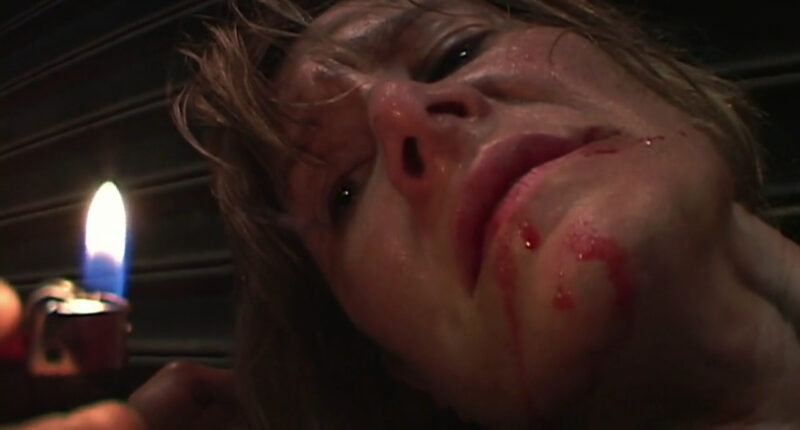
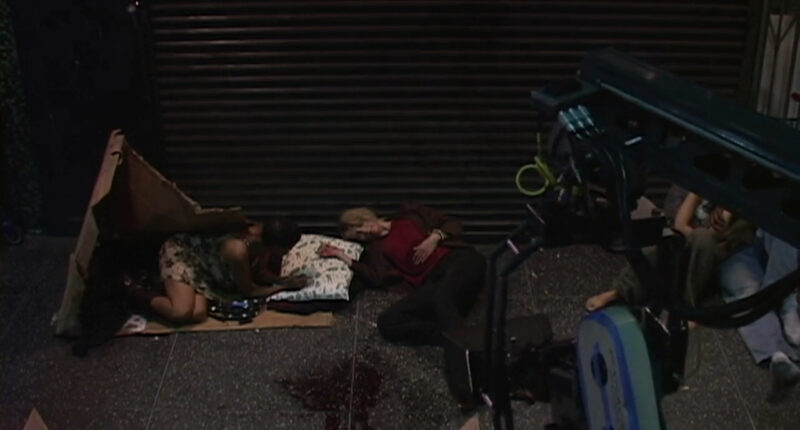
Nikki walks out onto the studio lot. We then cut to the Lost Girl, who is watching live footage of Nikki on her television. Nikki walks into a theater, where the footage of her interview with the policeman is playing. “I guess after my son died, I went into a bad time,” Nikki says on screen. “When I was watching everything go around me while I was standing in the middle. Watching it, like in a dark theater, before they bring the lights up.” On the screen, Nikki looks down at the screwdriver in her hand, and then walks across a room towards a red lamp. Then Nikki inside the theater sees the policeman from the screen walk through the theater, then up a set of stairs. She follows him, then walks through a door labeled “Axxon N.”
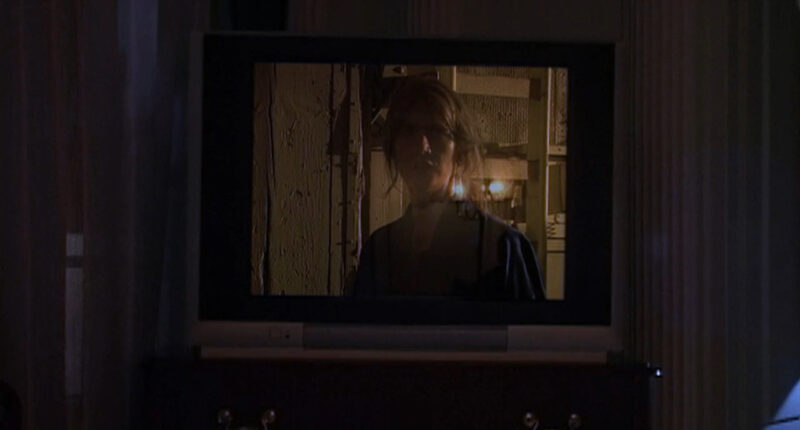
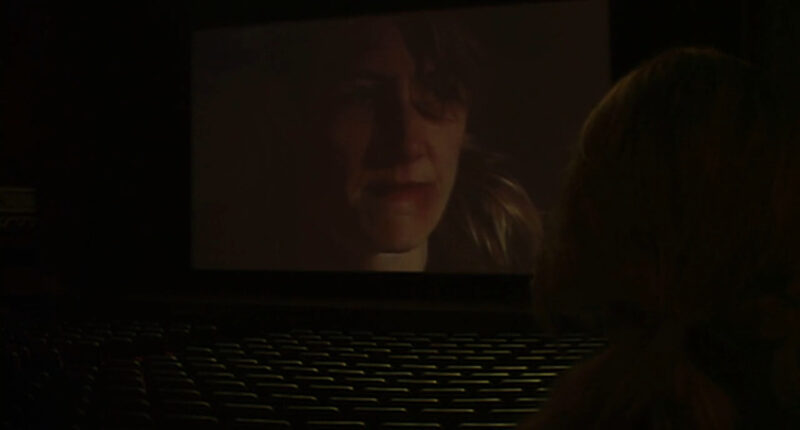
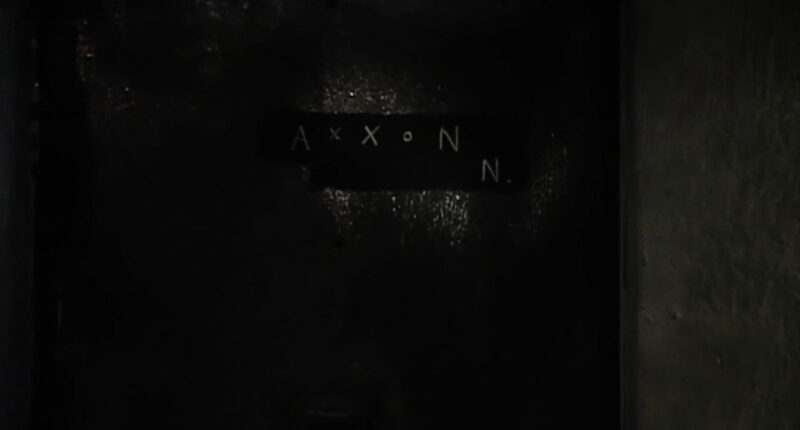
In that room, she walks up to the red lamp she saw on the theater screen. She opens a dresser and picks up a gun. She walks through several hallways and finds a door marked “47.” From around the corner, the Phantom appears and walks towards her. Nikki shoots him with her gun and a bright light shines in his eyes, practically blinding him. He stands still, dazed by the light. Then Nikki’s terrified face is superimposed over the Phantom’s face. She shoots one last time, and blood pours from the superimposed face’s mouth.
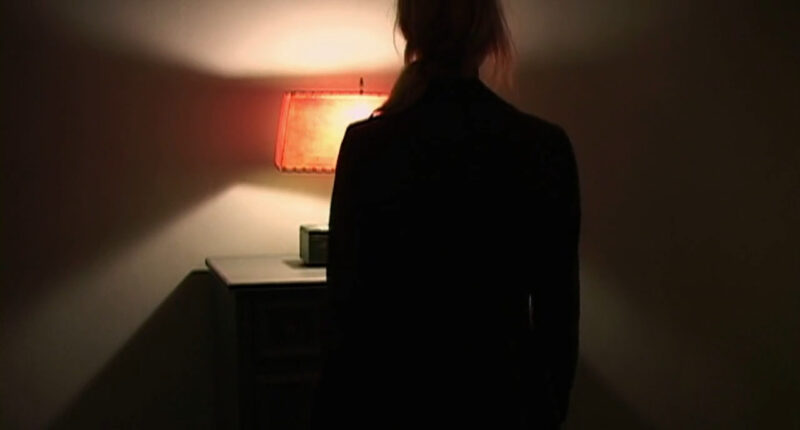
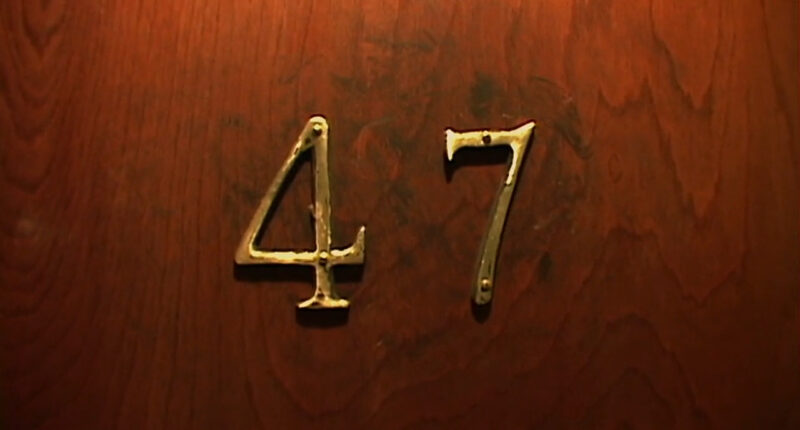
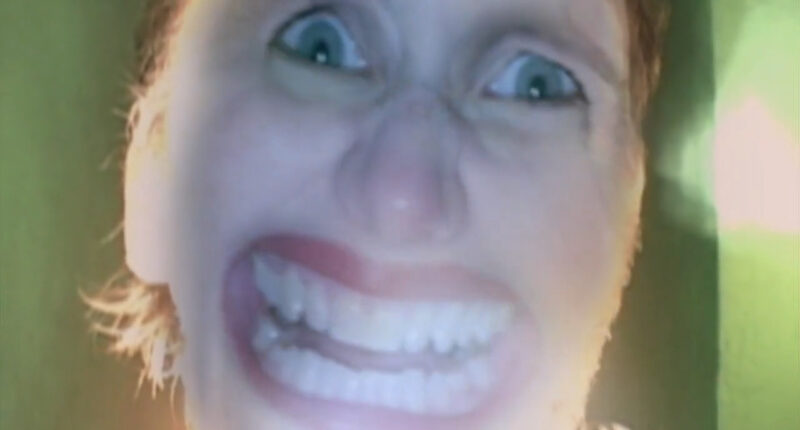
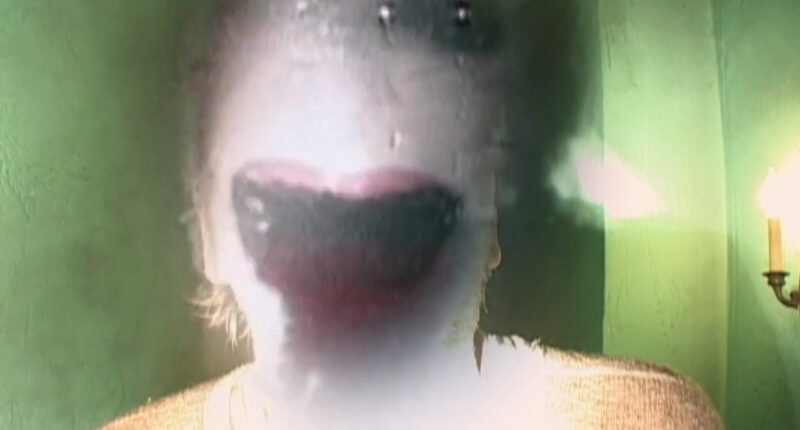
We then cut to a shot of the human rabbits in their apartment. They turn towards the door, which slowly opens. A light from the hallways flashes across their room. Nikki then walks backwards from the hallway into the room, revealing that the rabbits inhabit apartment 47. The rabbits are now gone, and in the room is a bright shining light.
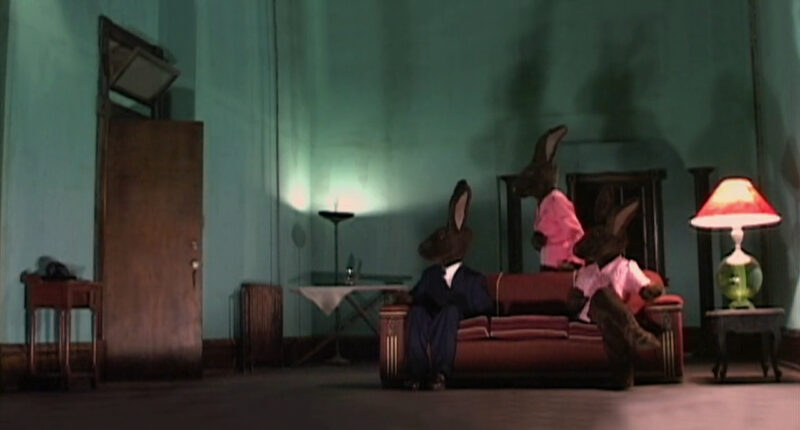
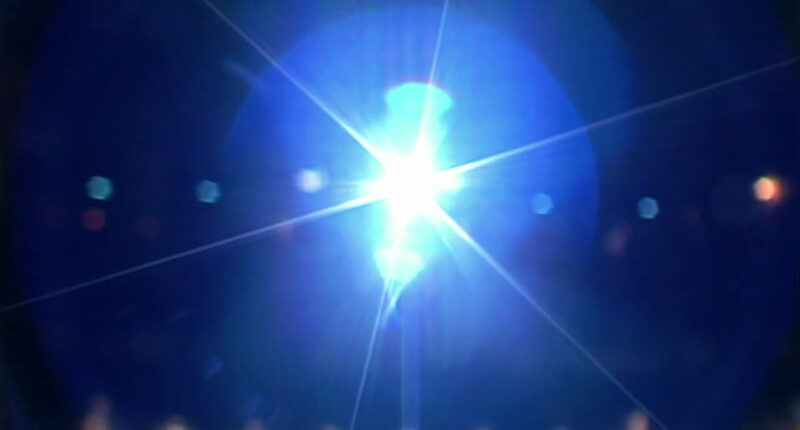
We then cut back to the Lost Girl, who is watching two prostitutes run through the hallway of the apartment building on her television. They appear to be running away, apparently freed by Nikki after killing the Phantom. Then the Lost Girl’s television shows Nikki walking into her room. Nikki and the Lost Girl embrace and kiss. As they kiss, Nikki disappears. Then the Lost Girl exits her apartment and walks down several hallways. She reaches the room marked “Axxon N” and embraces a man and a boy who appear to be her husband and son.

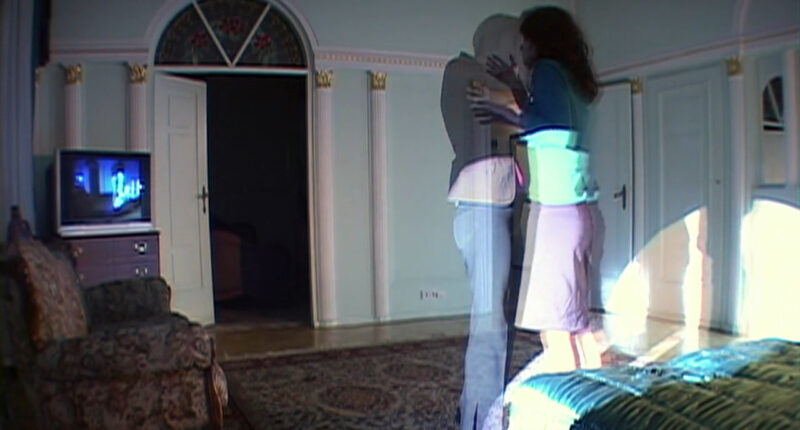

We cut back to the shining light from apartment 47, which fills the screen and fades into a shot of Nikki, who stands in a room as a light shines brightly on her face. A dancing ballerina is lightly superimposed over Nikki’s face. The camera cuts to reveal that the bright light is coming from the projection booth of a theater. Then the camera fades back to the Lost Girl and her family, then fades into the scene from the beginning of the movie when Visitor #1 comes to Nikki’s home. This time when Nikki looks over at the couch, however, she sees herself calmly sitting alone in a powdery blue dress.
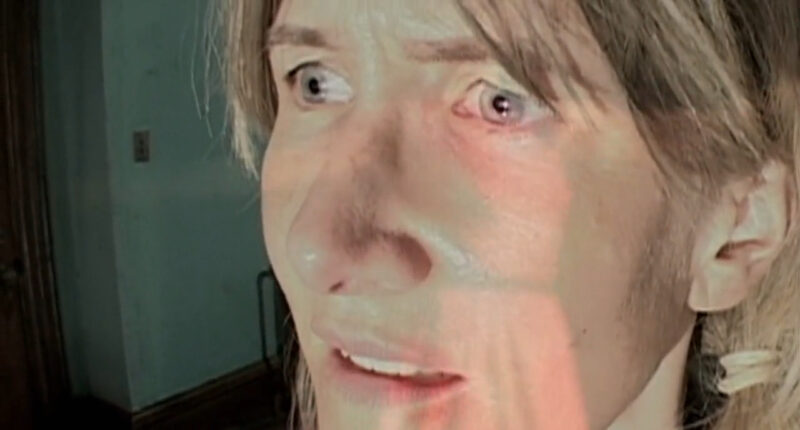

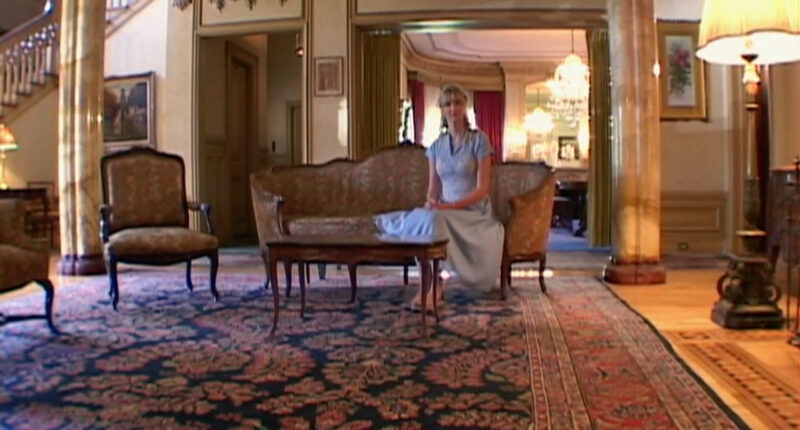
Then a credits scene initiates. This scene features several people—some new, some who were referenced at certain points, and some characters we’ve never seen. The movie ends with a song and dance number from several women.

The meaning of Inland Empire‘s ending
As we’ll discuss throughout this guide, it’s difficult to construct an objective reading of Inland Empire‘s story. Lynch shot the film over the course of several months as ideas came to him for scenes, and there was never a master script. Dern herself said that she wasn’t sure what her character’s story was. “I understood who each woman was and I understood what her pain may be about,” Dern told MacLachlan on the special features of Criterion Collection’s Blu-ray release of the film, “but not necessarily how I got there or where I would go next.”
Still, I believe there’s a way to read this ending that lines up with the two main themes: “our changing perception of cinema” and “the scattered fragments of our selves.” While I don’t know if anyone will ever provide a 100% conclusive reading of Inland Empire, I believe my theory about the meta nature of this movie comes close.
My theory involves two parts. First, let’s take a broad, philosophical look at the ending. This will then allow us to answer some more specific questions.
The meta implications of Inland Empire‘s ending
As we discussed in the themes section, the scattershot structure of Inland Empire inherently addresses our fragmented psyches. We often vacillate between the person we’d like to be and the person we feel pressured to be and the person we’re afraid to become. In order to inhabit such a tumultuous character that would embody this universal feeling, Lynch never gave Dern a hint about her character journey beyond that she was “a woman in trouble.”
So let’s address the scene where the homeless woman lights a lighter for Dern’s character as she dies on the sidewalk (we’ll come back to the monkey that shits everywhere later). It’s a beautiful moment that serves a very meta purpose—for both Nikki (inside the movie) and Dern (outside the movie). Because, as it’s revealed, this scene is actually a moment from the movie Nikki is filming, On High in Blue Tomorrows.
Let’s consider a quote from Dern about this specific scene: “David wanted me in the same position at the audience, which is: We don’t know what’s unfolding. We don’t know the miracle of one thing a person’s going to tell you who’s a stranger in your life and how it may impact the rest of your life.” This is a key thing to understand: neither Nikki nor Dern understand their character’s journey at any moment. They are simply responding to what is happening right then and there—recognizing this aesthetic is crucial for understanding the ending of the film.
Think about how seamlessly the movie jumps back and forth between “fantasy” and “reality”:
Inland Empire situates this scene within a narrative where Nikki is filming a movie, but gets lost in her character. Thus, when she realizes the scene with the homeless woman was for a movie, she’s dazed and confused. But then the ethereal scenario she’s been stuck in the entire time continues, and Nikki wanders off into a strange, ethereal realm where she must kill the Phantom and set the Lost Girl free. In one moment, we are led to believe that Nikki has been transported back to reality. But before long, she’s lost in the labyrinth of Inland Empire once again.
This constant back-and-forth is a key component of the movie. As beautifully detailed by Jodi Brooks in her analysis of the film, Lynch constantly makes poetic use of the shot/reverse shot structure in Inland Empire. Typically, the technique is used to depict a conversation between two people. But in Nikki’s case, she is constantly subjected to a shot/reverse shot that thrusts her between several characters and settings, upsetting the logic of time and space we’re used to in cinematic narratives:
In scene after scene, Nikki fractures into versions of herself and versions of her character that she does not recognise in sequences that seem to endlessly delay or trouble a reverse shot. This dynamic is established in opening scene when Nikki is visited by the mysterious so-called neighbour (Grace Zabriskie). In scene after scene, Nikki fractures into versions of herself and versions of her character that she does not recognise, in sequences that seem to endlessly delay or trouble a reverse shot. This dynamic is established in the opening scene when Nikki is visited by the mysterious “neighbour” (Grace Zabriskie). After a number of shot/reverse shots of the two women’s faces in distorted close-up, we move to a close-up of Nikki’s face as she turns to look at the place where (she is told) she will be sitting tomorrow. Nikki slowly turns her head and looks off-screen, and this look is answered by a long shot of Nikki and some of her friends seated on a sofa in the far distance of the palatial room. The shot/reverse shot structure here serves to fracture any sense of a coherent narrative space or time, instead throwing our attention to the blind field that it traces. This establishes the particular shot/reverse shot structure or logic that the film will be structured around, one in which the reverse shot always problematises the ‘here’ of the shot.
Jodi Brooks, “Cinema, Disappearance and Scale in David Lynch’s Inland Empire“
The movie Nikki is trying to complete, On High in Blue Tomorrows—which is actually a remake of a movie called 47 that was never finished—is constantly unraveling and revealing new layers. As the movie progresses, the movie continually disappears as well. Which is disorienting. Thus, the shot/reverse shot technique that Brooks writes about instills a crucial component of the film: that neither Nikki nor Dern understand their character’s journey at any time. They are moving from one scene to the next, dealing with the pain of the present moment as an actress.
Which, when you think about it, is what life feels like. We go through this world shifting between various personalities, trying to discover who we truly are. And what better way to visually capture that journey than through an actress? Or, better yet: an actress playing an actress? You’re not only processing your character’s pain, but your processing another actress who’s processing another character’s pain. What a challenge!
Dern agrees. “In a way,” she told MacLachlan, “the performative aspect of multiple characters, the woman inside the woman inside the woman, is: Whose fantasy is it? Is the actress playing this broken homeless woman in trouble? Or is this woman in trouble dreaming of these different lives? And that was awe inspiring. And so that put me on my own internal journey so I could discover it for me.”
You could think of the entire film as an internalization of Nikki’s vulnerable state. While she was once a prominent actress, her career had been dwindling—until On High in Blue Tomorrows, which potentially presents a comeback moment for her. She’s anxious about whether she’ll get the part. And, technically, she never gets the part—she only imagines herself getting the part after Visitor #1 initiates a vision. As Brooks details, this shot/reverse shot moment sets up the inherently manipulative, incoherent aesthetic of the film. What we’re watching is completely inside her own head, meaning that every character, every scary situation, every twist and turn is nothing more than a representation of her fears and anxieties as she awaits to hear whether she’s secured this new role.
All of this applies to Dern as well. She didn’t know what she was signing up for when Lynch approached her with a 14-page monologue that, over the period of several months, warped into a three-hour cryptic epic called Inland Empire. Philosophically, the movie becomes an exploration of walking down that scary path towards discovering who you are. And by doing that, both Nikki and Dern are able to find catharsis.
A simple way to understand Inland Empire‘s ending
To me, this mentality helps explain several of the other outstanding questions you may have about the ending. For instance, because 47 was never completed, the Lost Girl was trapped in the apartment building. As she played a young prostitute character in the movie, the actress was eternally trapped in this terrible role that kept her separated from her real-life family. And until the movie is completed and her character is freed by somebody—which Nikki does—the Lost Girl cannot return to her husband and son. Thus, by freeing this woman from the curse of her uncompleted movie, Nikki symbolically addresses her own fears about reentering the movie business and discovers her true self through the Susan role.
Through this reading you can think of the apartment building in which the Lost Girl is trapped as a symbolic display of those fears. The Lost Girl sees everything that happens in the apartment building on her television. As we eventually find out, the apartment building exists on a movie set, meaning she’s been trapped there since being murdered. Thus, everything on screen serves as a source of torture. The rabbits, for instance, say the most inane, mundane statements in a sitcom format. She cries as she watches it. The Lost Girl is essentially forced to watch mindless television for eternity.
But, eventually, Nikki appears on that television. And before long, Nikki is able trace where the Lost Girl resides and kill the Phantom (with her own face superimposed over the Phantom, Nikki comes to envision herself as her own biggest adversary). Her ability to traverse the apartment building and eventually embrace the Lost Girl is, once again, a moment of self-realization for her character. In this imagined scenario where a woman was murdered on the set of 47, Nikki essentially crafts a maze in order to ready herself for On High in Blue Tomorrows. And at the center of that maze is a woman who can be freed from the horrors of her unfinished movie. It’s a symbolic way of Nikki confidently saying, “I’m ready to make my comeback.”
So after the Lost Girl is freed and returned to her family, Nikki fades away from this torturous labyrinth and appears in a movie theater with a light shining on her. This, in my opinion, is a nod to Dern the actress. As we’ve noted, Inland Empire is meta in multiple senses, as Lynch sent Dern down a winding path of self-discovery by inhabiting so many different characters. And Lynch seems to be acknowledging Dern and the movie itself both times she appears in a theater:
The first time was right after filming the death scene for On High in Blue Tomorrows. She wanders off set into a theater, where her discussion with the policeman is playing. This, it turns out, was the original 14-page monologue Lynch wrote for Dern that initiated the entire Inland Empire experience.
The second time Dern is in the theater, the ballerina superimposed over Dern’s face is a short film from Lynch called Ballerina that he shot while making Inland Empire. These two meta entities fuse to connect Dern the actress with Lynch the filmmaker—the interpreter with the creator. It’s an awe-inspiring alignment that speaks to the power of art to transcend the screen and capture the surreal beauties of life. Lynch created a movie that pays homage to the power of film—that allowed Dern to discover new parts of herself through a myriad of roles, that illustrated the universal pains of humanity for everybody watching. It’s a moment of meta cohesion that brings catharsis to the film’s vast array of ideas.
This, then, explains the rest of the movie. After completing their journeys, both Nikki and Dern return to the real world. But instead of envisioning a nightmarish scenario, they now see themselves dressed in angelic blue on the couch. They are content and ready for whatever comes next.
You can then think of the credits scene as a celebration. Many characters return—yes, even the monkey who shits everywhere—to dance and sing and smile for the women who made it through such a trying experience.
The themes and meaning of Inland Empire
Our changing perception of cinema

It would undoubtedly prove fruitless to examine the narrative structure of Inland Empire from a linear perspective. Anybody—which includes myself—who ran to the internet to search “inland empire explained” after watching Lynch’s 180-minute low-res epic is undoubtedly searching for simple answers that pertain to traditional narrative structures. But if you know Lynch, then you know there are no simple answers. And particularly in the case of Inland Empire, the narrative is not laid out in the traditional, linear format to which we’ve become so accustomed. While this might make Inland Empire seem intimidating, I would argue it’s actually quite liberating. Our understanding of Inland Empire does not require us to understand the chaotic spatiotemporal landscape of Lynch’s experimentation, but instead to look within, to observe the audience’s relationship with movies, to contemplate cinema’s changing complexion in a world where digital has overtaken celluloid.
It’s no secret that Lynch shot Inland Empire on a PD-150, an outdated low-end digital camera that doesn’t even run at 24p—a mode which was designed to deliver an image that looks somewhat like film, as opposed to Inland Empire‘s unmistakable home video aesthetic. As Amy Taubin aptly writes in her essay, “The visuals in Inland Empire look as if they’re decomposing before your eyes, as if any minute they are going to disappear into a void, and the extreme lighting adds to the effect of the film’s porous borders.”
This is our first and most overwhelming clue as to why we cannot approach Inland Empire like we approach traditional linear films from Hollywood: Lynch’s movie actively engages an aesthetic that rests outside our comfortable perception of cinema. Inland Empire was shot on a low-res camera and transferred to a 35mm, which, as Jodi Brooks writes in her essay, “troubles our sense of detail, image and screen scale.” The image presented in Inland Empire is, inherently, an image we’re not used to. From the word go, the very visual makeup of Inland Empire challenges our traditional notions of what cinema is and how we relate to it and understand it.
Lynch embellishes that aesthetic through Nikki’s story, which sends Dern down several twists and turns that seemingly share no narrative connections in the traditional linear sense. As an audience, we do not observe a discernible narrative thread that can be easily blueprinted, but instead an amalgamation of personalities that visually captures the chaotic mental landscape of human beings—all the anxieties and pleasures and fears and wonders that accompany the everyday. The home video aesthetic intimately intertwines the viewer with this woman’s misery, with this woman’s inevitable catharsis.
Lynch’s entire approach inherently initiates discomfort: we begin the movie with the purpose of active engagement, only to find that Lynch’s aesthetic requires us to transcend our traditional understanding of cinematic narratives in order to fathom this woman’s harrowing journey. It’s comfortable being an omniscient viewer who relies on accepted narrative rules—but the second a movie drifts outside that comfort zone and forces us to intimately engage with the character, our sense of direction is immediately thrown. Instead, we are asked to simply be part of the movie and confront that the complicated nature of the human psyche can (and perhaps should) be illustrated through means beyond our traditional understandings.
Lynch himself claimed he chose the PD-150 camera as a means of replicating the look of Old Hollywood films. Which creates inherent tension, as old movies were shot on film stock, a notably unreliable format that is subject to deterioration with time—unlike digital, which can ostensibly last forever due to its immateriality. While a majority of film reels have remained intact, they have developed unmistakable blemishes—while many others have been lost to time completely. Which means that Lynch chose a seemingly indestructible format (digital) to replicate an undeniably precarious format (celluloid). Brooks argues that this very conscious decision illustrates Lynch’s idea of cinema: “In many respects what anchors (Inland Empire), what gives it a centre around and through which it fractures, loops, and dissipates, is precisely the idea of cinema that it summons—an idea of cinema that crucially involves ideas of scale and an experience of disappearance.”
This entire idea gains texture and becomes meta when Kingsley, the director of On High in Blue Tomorrow, reveals to Nikki and Devon that their movie is a remake. And not just a remake, but a remake of a movie that was never finished. “Well, after the characters had been filming for some time, they discovered something in—something inside—inside the story,” Kingsley says. “The two leads were murdered. It was based on a Polish Gypsy folktale. The title in German was Vier Sieben—Four Seven. And it was said to be cursed. So it turned out to be.”
This further contributes to the aura of disappearing film, that movies can exist one moment and be gone the next. It’s not just the movies themselves we lose, but the people within those films—the characters, the actors who portray those characters. This especially relates to Dern’s array of characters, who slip in and out of each other at whim. Much like our relationship with these characters, Dern herself is constantly losing the character she previously inhabited. Only to, once shooting was completed, to become herself again. But do the characters ever truly leave? Doesn’t she continue to hold pieces of them inside herself? And doesn’t the viewer’s relationship with those characters continue? Despite whatever happens to the original footage?
In this way, you can think of Inland Empire less as a traditional story from which we enjoy some comfortable distance and more as a physical confrontation; a psychological labyrinth that challenges our very notion of cinema and our relation to it. There are both no connections and seemingly endless connections between all the characters played by Dern. From one second to the next, Nikki disappears and becomes Sue, who disappears and becomes whatever unrecognizable entity awaits. Just as Nikki is unaware of herself, we are unaware of her self—precisely in line with Lynch’s aesthetic.
Dern’s characters represent the complicated makeup of not only the human soul, but how we observe the human soul. Art blossoms our understanding of humanity through story and character, and cinema has perhaps allowed that art to flourish like never before—but the structure of those stories can evolve just like the very nature of cinema can evolve. From celluloid to digital and back again, Lynch crafted an aesthetic with Inland Empire that, I must stress again, is liberating. We are not asked to explain and understand Inland Empire, but to experience it as we experience our own lives.
The scattered fragments of our selves
Stemming directly from the above discussion is another dominant theme: the fragments of our very beings. In a conversation with Kyle MacLachlan in the special features of Criterion Collection’s Blu-ray release of Inland Empire, Dern spoke of her trying experience to understand Lynch’s approach to her character(s). “I understood who each woman was and I understood what her pain may be about,” Dern said, “but not necessarily how I got there or where I would go next.” Dern accepted that path as an actress because she knew that experience would be replicated with the audience: “David wanted me in the same position at the audience, which is: We don’t know what’s unfolding. We don’t know the miracle of one thing a person’s going to tell you who’s a stranger in your life and how it may impact the rest of your life.”
In addition to challenging the viewer’s perception of cinematic narratives and exploring our relationship with film, I believe Lynch also crafted a very straightforward character study of a woman. After all, when Dern asked Lynch (a director notable for never explaining his movies) if he could tell her anything about her character, he simply said, “She’s a woman in trouble.” That was enough for Dern to recognize what Inland Empire was truly about:
I really understood that. That’s all I needed to know. It scared me even more that she didn’t know (what was happening to her). And in a way, the performative aspect of multiple characters, the woman inside the woman inside the woman, is: Whose fantasy is it? Is the actress playing this broken homeless woman in trouble? Or is this woman in trouble dreaming of these different lives? And that was awe inspiring. And so that put me on my own internal journey so I could discover it for me.
Essentially, Lynch asks us to understand the psychological makeup of Dern’s character without worrying about spatiotemporal relations. “I understood who each woman was and I understood what her pain may be about,” Dern told MacLachlan, “but not necessarily how I got there or where I would go next.” Because, in the end, does it matter if we know which characters are real and which aren’t? Which are full-fledged beings and which are symbolic representations of the human psyche? At the end of the day, they’re all real, as all these characters played by Dern are simply pieces of a larger whole. We’re never just a single person, but an amalgamation of personalities that shift and evolve and alter as we move from place to place, person to person.
Anybody can recognize this journey in themselves, as we constantly vacillate between the people we’d like to be and the people we’re pressured to be and the people we’re afraid to become. Really, Nikki’s journey is no different than Nina’s journey from White Swan to Black Swan in Black Swan, other than Darren Aronofsky chose a traditional character narrative for Nina and Lynch chose an experimental approach for Nikki. Those two characters go through similar variations and rhythms, with the only difference being the structure and format.
When viewed from this perspective, the movie becomes much less intimidating. There is no need to explain how characters get from one place to the next. Instead, as Dern says, you simply understand each woman and what her pain is about.
And there is crucial information that links all that pain together. One woman is an aging actress and hoping to make a comeback. Another woman is scared of her husband’s controlling nature. Another was hardened by the men who physically and mentally abused her over the years. Another is stricken with grief over losing her son. Another is a prostitute. Another is homeless. Another is stabbed with a screwdriver. Another is irrevocably lonely (actually, that last one applies to all the characters). All these stories serve as representations of the crevices and spaces of the human psyche we don’t actively acknowledge, yet cannot deny.
Lynch chose a perfect aesthetic for this exploration, as the meta narrative of Inland Empire forces the very star of the film, Laura Dern, to inhabit those scary spaces that hover in the periphery. “It took me to the edge of my own darkness,” Dern told MacLachlan. “The fact that I didn’t know why I was there at times was that much more terrifying. Losing my sense of self. Acting out something behavioral. There was terror in the spaces.”
That, to me, is the most inspirational part of Inland Empire: the confrontation of those spaces. Readily accepting terror into our lives because denying that the terror exists in the first place is a lie we tell ourselves to feel more comfortable. But, inevitably, as life beckons and commands our selves, we find ourselves in those scary spaces. And while it’s scary, those are the moments we change and evolve for the better. That’s why the end of the film feels so celebratory: Dern finished the movie. She came out the other side of such a trying experience with a smile on her face. There’s such liberation in confronting our fragmented selves.
Why is the movie called Inland Empire?

While the meaning behind the title might seem obvious—as Inland Empire encompasses a stretch of California cities, including San Bernardino and Riverside, that border Los Angeles and Hollywood—movies aren’t necessarily associated with the two-county region. Yes, some famous films have been filmed there, such as Erin Brockovich and The Fast and the Furious. And yes, filming in the the region did account for over $1 billion between 1994 and 2005. But no large production companies or film studios are based in Inland Empire. And Lynch never actually shot any scenes there for Inland Empire. Really, the area isn’t as synonymous with the movie industry as you might think.
So why did Lynch name his movie after the area? Because the director is so tight-lipped about his films, we may never know for sure. But we sure can speculate.
Let’s start with each of those words. “Inland” means “situated in the interior of a country rather than on the coast” or “in or toward the interior of a country.” A fairly innocuous word. But “empire” has a much more foreboding power: “an extensive group of states or countries under a single supreme authority” or “a large commercial organization owned or controlled by one person or group.”
These two words combined own an ominous aura that feels very Lynchian. The director said his hometown of Philadelphia was the biggest influencer on his career. Ridden with crime, poverty, and death, the industrial city came to embody the dark undertones of his films, as even the most benevolent of Lynch characters discover that extreme darkness lurks just beneath their surface. Specifically, the industrial environment of Eraserhead, Lynch’s first feature film, was heavily influenced by the fearful tension in Philadelphia (Lynch called it his The Philadelphia Story).
Essentially: the characters of Lynch’s movies are heavily impacted by seemingly familiar surroundings that secretly contain dark truths. Think of the suburbanesque American Dream setting of Sandy’s life contrasted with the filth and squalor of Frank Booth in Blue Velvet. Or the small-town setting of Twin Peaks: Fire Walk With Me, where nobody thinks anything bad will ever happen, yet reveals itself to serve as a nightmarish harbor for lurking evil. The characters of these movies have one perception of their environment, only for it to be upturned and thwarted.
With that in mind, “inland empire” seems to coincide with that Lynchian trope. Especially when you consider that crime historically runs rampant in places like San Bernardino and poverty has continually been a problem. “Inland” conveys a setting that’s tucked away, and “empire” suggests an overarching power that controls its inhabitants. No, Inland Empire isn’t technically part of Hollywood. But it is Hollywood-adjacent, and its economy does benefit from the film industry. This gives the title a menacing atmosphere: Hollywood isn’t technically part of Inland Empire, yet Hollywoood looms over the city. The title “Inland Empire” makes the region feel illustrious, but once you move past the glitz and glamour of movies, you’ll find filth and squalor persist in the dark crevices.
This, to me, captures the imposing ambience of the movie’s title. Nikki lives a cushy life in her mansion. Hollywood has been good to her and brought her many years of success. Yet, internally, she’s a mess. She’s fearful of her husband’s controlling nature. Her career is on the decline. And she doesn’t like to acknowledge the ugliness of the world. But before she can reenter the movie business, she needs to confront her demons.
As we discussed in the ending section, the entire movie could be viewed as Nikki’s vision after Visitor #1 visits Nikki’s home. Nikki envisions herself receiving the part of Susan in On High in Blue Tomorrows, and everything follows could be viewed as a symbolic representation of the fears and anxieties at this stage in her acting career, in her life. While movies have provided wealth and prosperity, acting forces actors to confront every component of themselves—including the dark side. Dern herself said of the role: “It took me to the edge of my own darkness. The fact that I didn’t know why I was there at times was that much more terrifying. Losing my sense of self. Acting out something behavioral. There was terror in the spaces.”
This tumultuous journey through several different characters and settings is representative of Nikki (and, in meta fashion, Dern herself) working through those demons, all in an effort to discover her true self and ready herself for the film. For this Hollywood role, Nikki must travel beyond the borders of Hollywood into a darker, more sickly realm where movies exist yet aren’t representative of the everyday darkness—that is hurdle between fear and enlightenment. That is Inland Empire.
Questions & answers about Inland Empire

Who is the Lost Girl and what does she represent?
If you want a much more detail breakdown of the Lost Girl, then check out the ending explanation. But here’s a simplified answer:
The Lost Girl represents the actress who died while filming 47. Ever since, her spirit has been stuck in the studio lot. She is forced to sit in that room and watch whatever’s playing on the TV screen. It’s that simple
Symbolically, the Lost Girl represents Nikki’s fear of entering Hollywood once again. Nikki is a veteran actress who’s been out of work and looking to make her comeback with On High in Blue Tomorrows. But she doesn’t know if she’ll get the part. And the anticipation of whether she’ll get the part serves as the emotional underpinning of the entire movie. So the limbo that imprisons the Lost Girl becomes a representation of this fear, as she personifies a sort of stasis that can grip actresses in the unforgiving realm of Hollywood.
The metaphorical freeing of the Lost Girl represents Nikki emotional catharsis in dealing with that situation. She’s able to find personal clarity before finding out whether she received the part. Thus, the movie goes much deeper than just being about an actress trying out for a part—Inland Empire is about her emotional journey as an actress and our relationship with films.
What are the rabbits and what do they represent?
If you want a much more detail breakdown of why the rabbits are there, then read my entire ending explanation. But here’s a simplified answer:
At first, we have no idea why we’re watching these rabbits regurgitate random sitcom lines while an audience laughs. But as the movie progresses, it’s revealed that the Lost Girl is watching these rabbits on a television screen, that these rabbits serve as a form of torture. As we discussed in the above question, her spirit awaits in limbo on the studio set after being murdered while filming 47. So her TV screen represents both stasis (the rabbits) and freedom (Nikki). We are subjected to such long, meaningless conversations from the rabbits in order to properly reflect the Lost Girl’s misery. But Nikki is eventually able to vanquish the rabbits and take over the TV screen.
Who is the Phantom? And why does Nikki kill him?
Just like the two above answer, it’s best that you read the entire ending explanation to understand why Nikki kills the phantom. But the simplified answer:
The Phantom is an ethereal spirit that mans the studio building that imprisons the Lost Girl. The Lost Girl is a representation of Nikki’s fear about reentering the movie business. So by killing the Phantom, Nikki metaphorically overcomes the fears she has regarding that journey.
Now it’s your turn
Have more unanswered questions about Inland Empire? Are there themes or motifs we missed? Is there more to explain about the ending? Please post your questions and thoughts in the comments section! We’ll do our best to address every one of them. If we like what you have to say, you could become part of our movie guide!


A few things to note (any interpretation of Inland Empire is always plagued by “remainders”): We don’t know that the man Nikki is talking to in the upstairs office (called “Mr. K” in the credits) is a policeman. I’m not saying he’s NOT a policeman, but it’s funny how our brain fills in blanks where Lynch has actually left things ambiguous. Furthermore, the first time we see Mr. K’s office, the male rabbit has just entered there and sat down in Mr. K’s chair. What are we to make of these details?
Great take on an amazing movie. Thanks
Thank you very much! Honestly there’s still more I’d like to write about.